Samsung SSD 850 EVO (120GB, 250GB, 500GB & 1TB) Review
by Kristian Vättö on December 8, 2014 10:00 AM ESTThree Bits and Three Dimensions: What's the Deal?
I've covered 3D NAND and TLC NAND in detail in the past and in this article I'll just explain what 3D technology means to TLC NAND and vice versa, so head over to the links above if you are in the search for a deeper analysis of the two technologies.
Truth to be told, 3D technology is ideal for TLC. The fundamental problem of TLC NAND has always been the limited endurance and performance, which is caused by the additional voltage states that are needed to store three bits (i.e. eight possible bit outputs) in one cell. With eight voltage states compared to four in MLC, TLC NAND is less resistant to wear out because it takes a smaller change in the cell charge to corrupt the cell value. Due to the way NAND works, the cells (or the insulators in the cell to be exact) wear out over time, which induces electron leakage that alters the cell charge and hence the voltage state. This gets worse with die shrinks because the number of electrons decreases, making the NAND even less tolerant to wear out.
The key aspect of 3D V-NAND is the process node. By going back to 40nm lithography, the number of electrons increase exponentially, which makes TLC a much more viable technology than it was with modern planar NAND. Obviously, V-NAND doesn't change the basics of TLC NAND because it still takes eight voltage states to differentiate all the possible 3-bit outputs, but thanks to the increased number of electrons there is more breathing room between the states and thus the cells are more error tolerant.
Samsung claims 10x reduction in voltage state overlaps, which is a massive change for the better. You can see how crammed the planar TLC voltage states are, so it's no wonder that the endurance is low because the states are practically overlapping at each point in the voltage distribution and hence even tiny changes in the cell voltage can alter the cell's voltage state.
The larger cell structure also enables higher performance because it takes less iterations to program a cell. With planar TLC NAND it took multiple very high voltage pulses as well as numerous verification process to reach the right charge, but with looser voltage distribution the programming process has less steps and thus takes less time.
And given the lower read/program latencies and less need for error correction, the power consumption is also considerably lower.
In addition to better latency and power consumption characteristics, Samsung claims doubled the density over its 19nm planar TLC NAND, but without knowing the die size of 128Gbit 32-layer TLC V-NAND, it's hard to say how accurate this is. There have been some whispering that the 128Gbit die would actually be identical to the 86Gbit MLC die because 86Gbit multiplied by 1.5 equals 129Gbit and at the silicon level MLC and TLC aren't any different, but for now that's just speculation.
What I do know is that Samsung started the mass production of TLC V-NAND later, which suggests that the two aren't completely uniform. Moreover, from what I know TLC NAND requires some changes to the peripheral circuitry in order to read three bits from one cell, so while the NAND memory arrays could be alike the die size is still likely at least slightly different. Anyway, we'll find out when Chipworks (or some other silicon analysis company) takes a closer look at the NAND die itself.


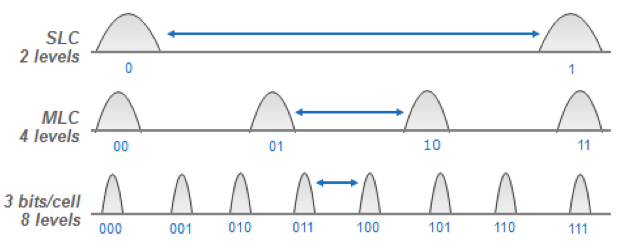
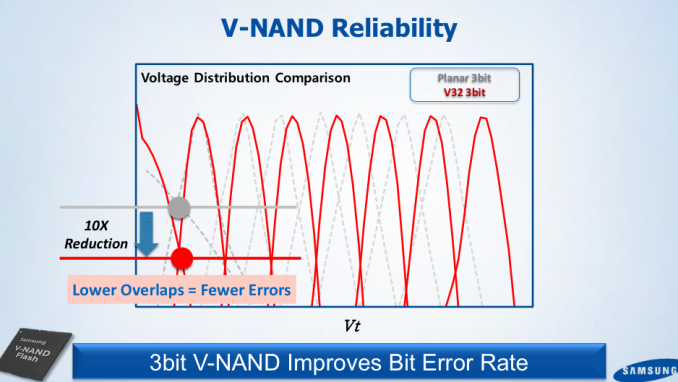
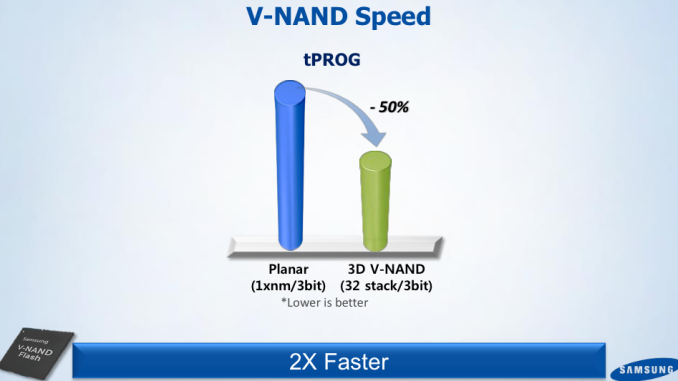
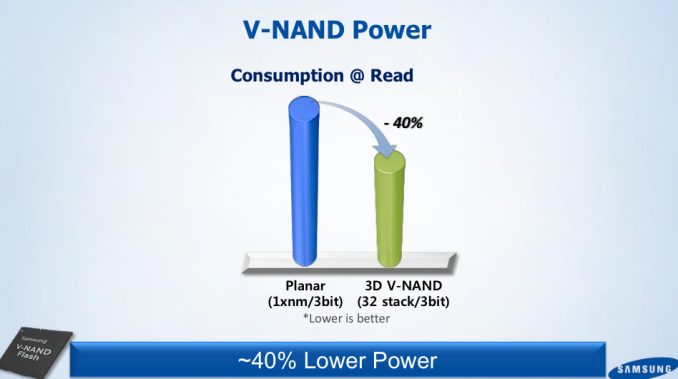
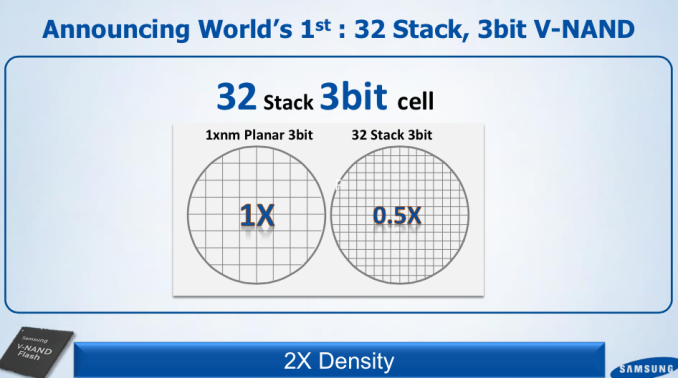








97 Comments
View All Comments
TheWrongChristian - Monday, December 8, 2014 - link
Performance consistency wise, the MEX controller on the 1TB drive looks better than the MGX controller on the smaller drives. I guess this is the loss of a cpu core at work, but I figure there'll be no discernible difference to the user experience.All in all, looks like a nice drive, a reasonable upgrade to the existing 840 evo drives. Just hope the V-NAND cost brings the whole price down to compelling levels as the process matures.
Solid State Brain - Monday, December 8, 2014 - link
As for the Wear Leveling Count, it might actually be taking into account that a fixed portion of the installed NAND is used in SLC mode for the TurboWrite buffer. The 120GB model has 128GiB of NAND, of which 9 GiB are used for 3 GiB TurboWrite Buffer, so that makes 119 GiB of TLC capacity for both overprovisioning and user addressable space.By the way, this also implies that because of TurboWrite these Samsung EVO SSDs (including the previous 840 EVO) have less overprovisioning space than most other SSDs.
Solid State Brain - Monday, December 8, 2014 - link
Yikes! This was not meant to be in response to TheWrongChristian.hojnikb - Monday, December 8, 2014 - link
>What I do know is that Samsung started the mass production of TLC V-NAND later, which suggests that the two aren't completely uniform. Moreover, from what I know TLC NAND requires some changes to the peripheral circuitry in order to read three bits from one cell, so while the NAND memory arrays could be alike the die size is still likely at least slightly different.Is it possible, that samsung designed 2nd gen 3D with TLC in mind (eg requred peripheral circuitry) and simply set the controller in 850PRO to use 4 states instead of 8 (so MLC). I mean, it kinda makes sense to go this way, but not the other way around....
Solid State Brain - Monday, December 8, 2014 - link
@Kristian VättöDo you have any information from Samsung about whether the TurboWrite SLC buffer also helps decreasing the write amplification like on the SanDisk Ultra II with nCache 2.0?
Kristian Vättö - Tuesday, December 9, 2014 - link
Unfortunately I don't. It was among the questions I sent but unfortunately Samsung couldn't get any of my questions answered on time for the review.Solid State Brain - Wednesday, December 10, 2014 - link
Too bad that you couldn't get an answer in time. According to my observations from other people's drives, it really looks like the Turbowrite does help on that regard. Try checking out my thread on the Memory and Storage forum.This phenomenon (write amplification just over or below 1.0x) is likely not going to show up during reviews or heavy usage since generally the drives get secure erased often and/or get hammered with writes which end up filling the Turbowrite SLC buffer.
Daniel Egger - Monday, December 8, 2014 - link
It would be nice to have some older drives in the charts to get some perspective on whether a drive would make a good upgrade choice. For an upgrade the available space and the space/price ratio are probably the most important aspects but some features or a major speed increase might sweeten the deal even more. ;)sheh - Monday, December 8, 2014 - link
Not perfect of always complete, but usable:http://www.anandtech.com/bench/SSD/65
Kvaern - Monday, December 8, 2014 - link
It's my anecdotal experience that all these awesome benchmark figures means absolutely nothing for the average user.Case in point I upgraded from an old 60GB corsair drive to an EVO840 which on paper is like twice as fast as the Corsair but in reality my user experience is exactly the same.